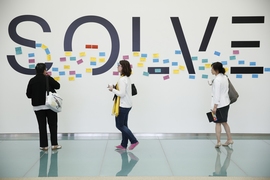MIT’s Solve program today announced its preliminary schedule of activities for fall 2016 and spring 2017.
Solve is a live meeting series whose mission is to cultivate a community to discover, evaluate, and advance technological solutions to global problems.
MIT President L. Rafael Reif announced Solve in 2014, and the series first convened last fall. “At MIT, we want to do good for the world,” Reif said in his opening remarks, adding, “With Solve, we want to accelerate positive change.”
At its first major event, Solve convened technologists, philanthropists, business leaders, policymakers, and change agents from around the world to examine and address problems where technology, business innovation, and smart policy can be leveraged to bring about real and lasting change. Since then, teams have taken steps on a number of issues, such as funding an inclusive innovation competition, easing the barriers to building a safe, cheap new nuclear reactor design, and planning a variety of projects in schools in Johannesburg, South Africa; Haiti; and Seattle, Washington.
The Solve program is organized around four “pillars”: Fuel, Learn, Cure, and Make. This year’s program poses five “challenges” within those pillars:
- Fuel
- Carbon price: How can new technologies (including digital currencies like Bitcoin) be used to put a price on carbon emissions and other greenhouse gases?
- Negative carbon emissions: How do we remove carbon dioxide from the atmosphere in a way that is scalable, economical, and ethical?
- Learn
- Refugee education: How can we improve learning in refugee camps to provide children there with a quality education?
- Cure
- Leveraging innovation: How can we use tools including mobile devices to help people with mental disorders such as dementia, schizophrenia, and autism?
- Make
- Inclusive innovation: How do we create a more inclusive, productive, and sustainable economic future for all?
These challenges were created by MIT faculty in consultation with various domain experts and thought leaders. In future years, challenges will be generated through a broad community, including academia, external advisors, crowdsourcing, industry leaders, and nongovernmental organizations; and councils of experts will select challenges where progress seems most likely.
Solve invites participants from around the globe to take part in the process by joining its community. The program is actively seeking proposals for the challenges. Individuals and organizations are encouraged to log in to the Solve CoLab platform to propose solutions.
Solve will showcase selected challenges and explore possible solutions at events throughout the year, starting with Solve at HUBweek, a city-wide festival in Boston held in the last week of September 2016, where attendees can propose their solutions. In spring 2017, MIT will gather a group of invited guests on its Cambridge campus to more deeply explore challenges in small interactive sessions, with the goal of creating and implementing actionable next steps.
Other regional Solve activities will be announced on an ongoing basis throughout the year.











